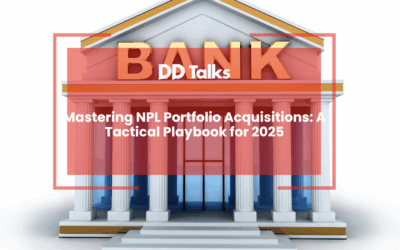Key Takeaways
- Emerging markets present unique NPL investment opportunities characterized by distinctive economic cycles, regulatory evolution, and higher potential returns compared to developed markets.
- Eastern Europe, Southeast Asia, and Latin America currently offer the most promising NPL investment landscapes, each with their own advantages in terms of regulatory frameworks and recovery potential.
- Success in emerging market NPL investments requires navigating varied legal frameworks, with particular attention to creditor rights, regulatory barriers, and enforcement mechanisms.
- Strategic market entry often benefits from local partnerships that provide market knowledge and operational capabilities, with timing and scale considerations being critical success factors.
- NPL valuation in emerging markets demands sophisticated methodologies that account for macroeconomic volatility, requiring robust scenario analysis and market-specific approaches.
- Comprehensive due diligence must extend beyond financial analysis to include legal, operational, and cultural factors that significantly impact recovery outcomes.
- Operational excellence in NPL asset management requires thoughtful development of servicing platforms, technology infrastructure, and human resources adapted to local market conditions.
Table of Contents
- Understanding NPLs in Global Emerging Markets
- Which Emerging Markets Offer Prime NPL Investment Potential?
- Navigating Legal Frameworks Across NPL Jurisdictions
- Developing Effective Market Entry Strategies for NPL Investors
- Mastering NPL Portfolio Valuation in Diverse Economies
- Conducting Comprehensive Cross-Border NPL Due Diligence
- Overcoming Operational Challenges in NPL Asset Management
Understanding NPLs in Global Emerging Markets
Non-performing loans (NPLs) represent a significant challenge for banking systems worldwide, but particularly in emerging markets where economic volatility can exacerbate default rates. These distressed assets, typically defined as loans where borrowers have failed to make scheduled payments for 90 days or more, create both risks and opportunities within the global financial ecosystem.
Emerging markets present a unique landscape for NPL investors due to their distinctive macroeconomic factors. Unlike mature economies, these regions often experience more pronounced economic cycles, currency fluctuations, and regulatory evolution—all of which influence NPL formation and resolution. The NPL market maturity varies dramatically across different regions, with some markets having well-established frameworks for NPL transactions while others remain relatively undeveloped.
The composition of emerging market NPLs also differs significantly from developed economies. Corporate NPLs often dominate in frontier markets, frequently tied to infrastructure projects, real estate developments, or state-owned enterprises. Retail NPLs, while present, typically represent a smaller portion of the distressed debt market in these regions. Understanding these fundamental characteristics is essential for investors seeking to navigate the complex terrain of emerging market NPLs.
Which Emerging Markets Offer Prime NPL Investment Potential?
The landscape of emerging market NPL opportunities is diverse and constantly evolving, with several regions currently offering compelling investment potential. Eastern Europe continues to present attractive opportunities, particularly in countries like Poland, Romania, and Hungary, where banking systems have undergone significant restructuring. These markets benefit from EU-aligned regulatory frameworks while still offering higher yields than Western European counterparts.
Southeast Asia has emerged as another hotspot for NPL investment, with Indonesia, Thailand, and Vietnam leading the charge. These economies combine robust long-term growth prospects with banking sectors that are actively seeking to clean up their balance sheets. The NPL recovery rates in these markets have historically been attractive, particularly for investors with local expertise or partnerships.
Latin American markets, notably Brazil, Mexico, and Colombia, represent another frontier for NPL investors. These countries feature relatively mature legal frameworks for debt recovery alongside significant volumes of distressed assets. However, investors must carefully navigate the region’s political and currency risks.
Emerging market NPL country analysis requires evaluating several key factors: regulatory openness to foreign investors, legal frameworks for debt recovery, macroeconomic stability, and the presence of established servicing platforms. Markets with a combination of high NPL volumes, reasonable recovery timelines, and improving institutional frameworks typically offer the most promising risk-adjusted returns for international investors seeking exposure to frontier market NPLs.
Navigating Legal Frameworks Across NPL Jurisdictions
The legal and regulatory landscape governing NPLs varies dramatically across emerging markets, creating both challenges and opportunities for investors. Understanding these NPL legal frameworks is fundamental to successful investment strategies, as they directly impact recovery timelines, enforcement mechanisms, and ultimately, investment returns.
Creditor rights represent perhaps the most critical aspect of any NPL jurisdiction. The strength and enforceability of these rights vary significantly, with some emerging markets offering robust protection for lenders while others present more challenging environments. Key considerations include the ability to access collateral, the efficiency of foreclosure processes, and the predictability of court decisions. Countries with clear bankruptcy codes and established precedents typically offer more certainty for NPL investors.
Regulatory barriers to entry also differ substantially across markets. Some jurisdictions restrict foreign ownership of distressed debt or require specific licenses to engage in NPL acquisition and servicing. Others impose data protection regulations that complicate due diligence processes or limit access to borrower information. Navigating these restrictions often requires specialised legal expertise and sometimes local partnerships.
The evolution of NPL regulations in many emerging markets has created a more favourable environment for investors in recent years. Banking regulators increasingly recognise the importance of functioning secondary markets for distressed debt as a mechanism for strengthening financial systems. This trend has led to regulatory reforms in markets from Spain to Southeast Asia, often creating windows of opportunity for early movers in newly liberalised NPL markets.
Developing Effective Market Entry Strategies for NPL Investors
Successful entry into emerging market NPL sectors requires carefully crafted strategies that account for local market dynamics, competitive landscapes, and operational realities. The most effective NPL market entry strategies typically begin with thorough market mapping to identify not only the volume and types of distressed assets available but also the competitive environment and potential local partners.
Partnership models represent a crucial decision point for international investors. Joint ventures with local financial institutions or established NPL servicers can provide invaluable market knowledge, regulatory relationships, and operational capabilities. These partnerships often prove particularly valuable in markets where cultural factors and local relationships significantly impact recovery outcomes. Alternatively, some investors opt for direct market entry through establishing their own platforms, which offers greater control but requires substantial upfront investment.
The timing of market entry can dramatically impact investment returns. Early entrants into developing NPL markets often secure advantageous pricing but face greater operational challenges and regulatory uncertainties. Later entrants benefit from more established market infrastructure but typically encounter more competitive pricing. Successful investors carefully analyse market cycles, regulatory developments, and banking sector pressures to identify optimal entry points.
Scale considerations also play a crucial role in entry strategy development. Some emerging markets offer sufficient NPL volume to support dedicated platforms, while others may only warrant opportunistic investments. Understanding the sustainable deal flow in a market helps investors determine appropriate resource allocation and operational models, ensuring that fixed costs can be amortised across an adequate asset base.
Mastering NPL Portfolio Valuation in Diverse Economies
NPL portfolio pricing in emerging markets presents unique challenges that demand sophisticated valuation methodologies adapted to local conditions. Traditional discounted cash flow models require significant adjustments to account for the heightened uncertainties in these markets, including volatile interest rates, currency fluctuations, and less predictable recovery timelines. Successful investors develop market-specific valuation approaches that incorporate these variables while maintaining disciplined risk assessment.
Macroeconomic factors play an outsized role in emerging market NPL valuations. Economic growth trajectories, employment trends, property market dynamics, and currency stability all significantly impact recovery prospects. These factors often exhibit greater volatility in emerging economies, necessitating more robust scenario analysis and stress testing in valuation models. Investors who excel at incorporating these macroeconomic variables into their pricing models gain a substantial competitive advantage.
NPL portfolio segmentation becomes particularly important in diverse emerging markets. Different asset classes—corporate, SME, retail, secured, unsecured—respond differently to local economic conditions and recovery processes. Granular segmentation allows investors to identify pockets of value within larger portfolios and develop targeted resolution strategies for each segment. This approach is especially valuable in markets where broad-brush valuation methods may miss significant variations in recovery potential.
Comparative pricing data often proves scarce in emerging NPL markets, making benchmark-based valuation challenging. Successful investors overcome this limitation by building proprietary databases of recovery outcomes, developing relationships with local market participants, and leveraging experience from analogous markets. This knowledge-based approach to valuation helps bridge information gaps and identify mispriced opportunities in less transparent markets.
Conducting Comprehensive Cross-Border NPL Due Diligence
Effective NPL due diligence in emerging markets requires a multidisciplinary approach that extends well beyond traditional financial analysis. Legal due diligence takes centre stage in cross-border NPL investments, with particular focus on loan documentation, security perfection, and enforceability of claims. The quality and completeness of documentation can vary dramatically across emerging markets, with some jurisdictions presenting significant challenges in establishing clear title to collateral or confirming the validity of guarantees.
Operational due diligence assesses the practical feasibility of implementing resolution strategies in specific markets. This includes evaluating local servicing capabilities, the efficiency of court systems, and the availability of exit options for resolved assets. Investors must develop realistic timelines for various resolution scenarios, accounting for local procedural requirements and potential bottlenecks in enforcement processes.
Data quality represents a persistent challenge in emerging market NPL due diligence. Loan tapes often contain incomplete or inconsistent information, requiring sophisticated data cleansing and gap analysis. Successful investors develop methodologies for extrapolating from limited data samples and validating critical assumptions through targeted sampling of physical files or site visits to collateral properties.
Cultural and relationship factors also warrant careful consideration during the due diligence process. Understanding local business practices, borrower behaviours, and negotiation norms can significantly impact recovery outcomes. This “soft” due diligence often proves as valuable as traditional financial analysis in predicting actual performance. Investors who combine rigorous analytical approaches with cultural sensitivity and local market knowledge typically achieve the most accurate due diligence outcomes in emerging NPL markets.
Overcoming Operational Challenges in NPL Asset Management
Managing NPL portfolios across diverse emerging markets presents formidable operational challenges that can significantly impact investment returns. Servicing platform development or selection stands as a critical decision point for investors. The availability and quality of third-party servicers varies dramatically across markets, with some regions offering sophisticated established platforms while others require investors to build capabilities from scratch. This decision involves careful evaluation of cost structures, performance incentives, and technological capabilities.
Technology infrastructure plays an increasingly important role in NPL asset management, enabling more efficient processing of high-volume portfolios and better data-driven decision making. However, implementing advanced servicing technologies in emerging markets often requires adaptation to local conditions, including connectivity limitations, regulatory requirements, and integration with local banking systems. Successful investors develop flexible technology approaches that balance sophistication with practical functionality in challenging environments.
Human resource challenges also feature prominently in emerging market NPL operations. Building teams with the right combination of local market knowledge, financial expertise, and cultural understanding requires thoughtful recruitment and training strategies. Many investors find that combining international best practices with local talent creates the most effective operational teams for managing complex NPL portfolios across diverse jurisdictions.
NPL resolution timelines in emerging markets typically extend longer than in developed economies, creating cash flow management challenges for investors. Successful asset managers develop phased resolution strategies that prioritise quick wins while simultaneously pursuing longer-term value maximisation for more complex assets. This balanced approach helps generate early returns while maintaining focus on overall portfolio performance. By addressing these operational challenges systematically, investors can significantly enhance recovery outcomes and investment returns in emerging market NPL portfolios.
Frequently Asked Questions
What are non-performing loans (NPLs) in emerging markets?
Non-performing loans in emerging markets are loans where borrowers have failed to make scheduled payments for 90 days or more. They typically feature higher volumes of corporate debt tied to infrastructure projects, real estate developments, or state-owned enterprises compared to developed markets. Emerging market NPLs are characterized by more pronounced economic cycles, currency fluctuations, and evolving regulatory frameworks that influence both NPL formation and resolution processes.
Which emerging markets currently offer the best NPL investment opportunities?
The most promising NPL investment opportunities currently exist in three main regions: Eastern Europe (Poland, Romania, Hungary), Southeast Asia (Indonesia, Thailand, Vietnam), and Latin America (Brazil, Mexico, Colombia). The best markets combine high NPL volumes, reasonable recovery timelines, improving institutional frameworks, regulatory openness to foreign investors, and established servicing platforms, offering attractive risk-adjusted returns for international investors.
What legal factors should investors consider before entering emerging market NPL sectors?
Investors should evaluate four critical legal factors: strength of creditor rights (including collateral access and foreclosure efficiency), regulatory barriers to entry (foreign ownership restrictions or licensing requirements), data protection regulations that may impact due diligence, and the overall evolution of NPL regulations in the target market. Markets with clear bankruptcy codes, established legal precedents, and favorable regulatory trends toward NPL market development typically offer more certainty for investors.
How should investors approach NPL portfolio valuation in emerging markets?
Effective NPL valuation in emerging markets requires adjusting traditional discounted cash flow models to account for heightened uncertainties, incorporating macroeconomic factors (growth trajectories, employment trends, property markets, currency stability), implementing granular portfolio segmentation by asset class, and developing proprietary recovery data to overcome the scarcity of comparative pricing information. This multifaceted approach helps identify mispriced opportunities in less transparent markets.
What are the most effective market entry strategies for NPL investors in emerging economies?
Successful market entry strategies begin with thorough market mapping, followed by selecting appropriate partnership models (joint ventures with local institutions or establishing proprietary platforms), timing entry to align with market cycles and regulatory developments, and determining the right operational scale based on sustainable deal flow. Early market entrants often secure better pricing but face greater operational challenges, while partnerships with local entities provide valuable market knowledge and relationships.
What operational challenges do NPL investors face in emerging markets?
The primary operational challenges include developing or selecting appropriate servicing platforms, implementing technology infrastructure adapted to local conditions, building teams with the right combination of local knowledge and international expertise, and managing extended resolution timelines that affect cash flow. Successful investors address these challenges by combining international best practices with local adaptations and developing phased resolution strategies that balance quick wins with long-term value maximization.
How comprehensive should due diligence be for cross-border NPL investments?
Cross-border NPL due diligence must be multidisciplinary, encompassing legal review of loan documentation and security perfection, operational assessment of local servicing capabilities and court systems, data quality validation with sophisticated cleansing methodologies, and evaluation of cultural and relationship factors that impact recovery outcomes. Investors who combine rigorous analytical approaches with cultural sensitivity and local market knowledge typically achieve the most accurate due diligence outcomes.




0 Comments